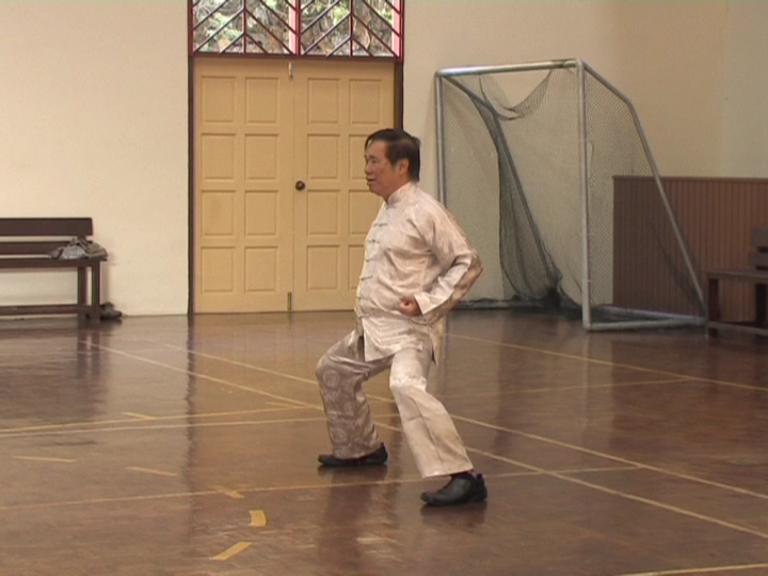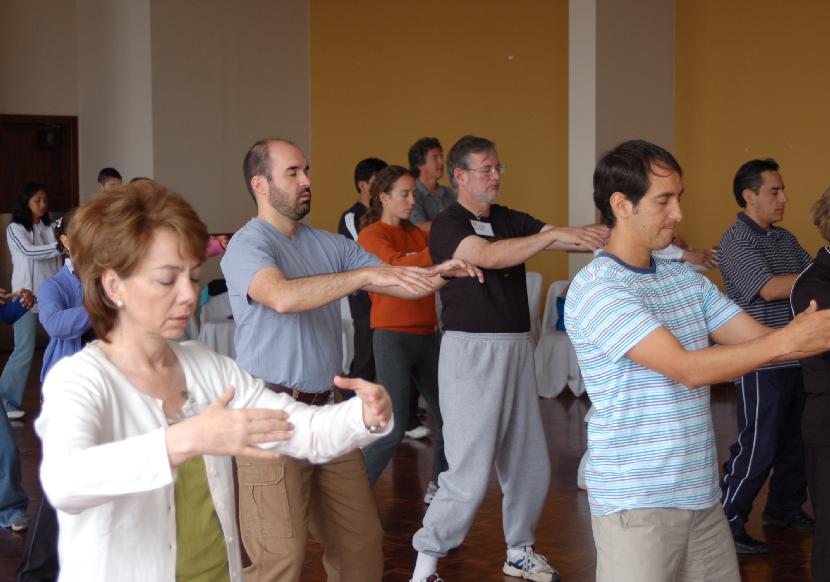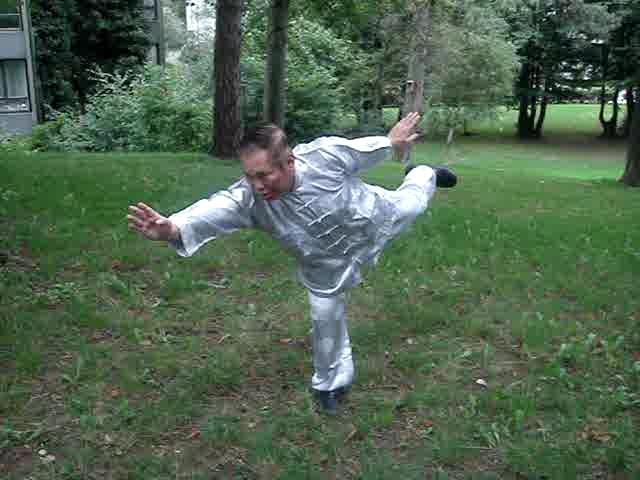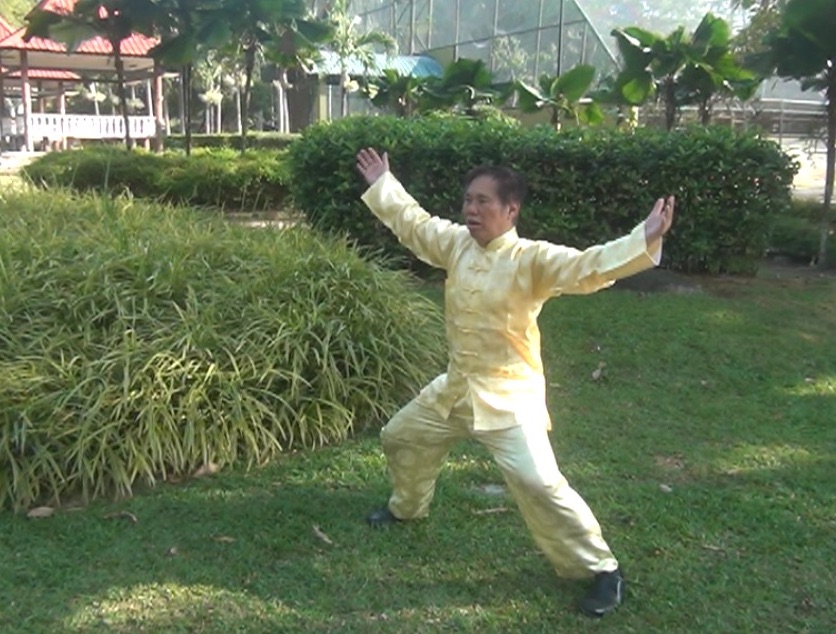SELECTION OF QUESTIONS AND ANSWERS
JULY 2018 PART 2

Grandmaster Wong performing the Horse-Riding Stance
Question 1
I heard some elderly people say that in China in the past people who trained kungfu spent many months just practicing the horse stance.
— Chan, Malaysia
Answer
That was true. I remember my father telling me when I first practiced kungfu from Uncle Righteousness more than 60 years ago, that people in China spent a long time, sometimes 2 years, just practicing the Horse-Riding Stance.
For example, Hoong Hei Koon, who was a famous Southern Shaolin master, practiced the Horse-Riding Stance every day for 2 or more hours. He had a lot of internal force. He could kill an opponent with just one punch.
In Uncle Righteousness' class, students did nothing else but only stance training for two to three months. This was one reason why Uncle Righteousness's students were well known for their solid stances.
When I first learned the stances, I just followed my seniors' advice. My senior classmates, Chiew Shi Khern and Wong Choy Wah, taught me the stances on behalf of my master.
Wong Choy Wah, who later became the Grandmaster of Chin Wah Kungfu Gymnasium, named after my master, Uncle Righteousness, whose real name was Lai Chin Wah, was famous for his internal force. Chiew Shi Khern was famous for his iron arm. Stance training must have contributed much to their achievement.
Question 2
Some people I know spend some months practicing the stance, but they do not get any benefit. For example, they do not develop internal force.
Answer
When I first learned stance training from Uncle Righteousness, I only knew that stances formed the foundation of kungfu. If a kungfu practitioner wanted his kungfu to be good, he must spend some time on stance training. All kungfu movements were performed on stances. Later I learned that stance training provided a lot of internal force and mental clarity.
To develop internal force, one must be relaxed. The more a person relaxes, the more internal force he can develop. This is a fact that many people find hard to comprehend.
To develop mental clarity, one's mind must be clear. In other words, he must be free of thoughts. The clearer his mind is, the more mental clarity he can develop.
Most people tense themselves when performing stance training. They may be relaxed at first, but very soon they tense their muscles. They take stance training to be an endurance test, i.e how long they can endure to tense their muscles to hold themselves in their stances. Tension blocks energy flow; flowing energy is essential to develop internal force.
When they tense their muscles, they also tense their mind. They become stressful. Hence they do not develop mental clarity.
Tensing their muscles and being stressful are the two most common mistakes most people commit when practicing stance training. Hence they do not benefit from their training.

Participants practicing the Three-Circle Stance
Question 3
Why many martial artists today start their martial arts without practicing any stance?
Answer
There are three important reasons why many martial artists today, including many who practice kungfu, inclusive of those who practice Taijiquan as Taijiquan is kungfu, do not spend time on stance training:
- They do not know that stance training develop internal force and mental clarity, which are essential in martial art.
- Even if they know, they are unable to get the benefits because they lack the necessary skills. They may know the techniques of performing the various stances, but they lack the skills to develop internal force and mental clarity.
- They think, wrongly, that good fighting does not need good stances.
Question 4
If Enlightenment is Universal Energy what is the state of Enlightenment for a phenomenal person?
— Marina, Russia
Answer
Enlightenment and the phenomenal realm are exclusive. In other words, one can only be in the phenomenal realm or in Enlightenment. He cannot be in both at the same time. Hence, in Enlightenment, there is only Universal Energy and nothing else. There cannot be any being or thing phenomenal.
The word "phenomenal" comes from the Greek word meaning "of appearance". The phenomenal things we see, like tables and chairs, people and trees, are phenomenal, which means they are only appearances. They appear to us as tables and chairs, people and mountains, because of our sets of conditions, like how our eyes see energy, how we feel energy, and how our mind interprets energy. Actually they are just energy, or "nothingness", but we see them as different entities, each different from another.
Different beings, like a butterfly or a bacterium, will see the same energy differently because they have different sets of conditions. A ghost, which is a being, may not see things that we see.
People are, of course, not the only beings in the phenomenal realm. There are other beings that we can see in our comparatively tiny world, like cats and elephants. There are beings, like ghosts and gods, who exist in another world and whom we normally do not see. There are many, many other beings who may be very different from what we conceptualize, who exists in many, many other worlds.
In Enlightenment, there is no differentiation, no differentiation into cats and elephants which we can see, no differentiation into ghosts and gods whom we cannot normally see, and no differentiation into any entities which may be totally different from our imagination. Enlightenment is just Universal Energy according to science, or nothingness according to Buddhist belief, or God the Holy Spirit according to Western culture.
Interestingly, there is also the age of enlightenment, which I use the small letter "e" unless it starts a sentence. Here, enlightenment means we know the underlying philosophy. It often includes thinking, or reasoning.
Enlightenment, with a capital "E", is very different from enlightenment, with a small "e". In Enlightenment there is no thinking, no reasoning. Once there is thinking or reasoning, Universal Energy, or nothingness, or God the Holy Spirit, transforms into differentiated entities.

"Swallow Flying through Clouds", one of countless forms in chi kung
Question 5
I didn't go to a doctor or made any test. I felt the tumor with my hands. Even if I still worry a bit because I have pain here and there, is it ok? I really enjoy my chi kung practice though without worrying or intellectualizing, will I recover with time?
Answer
Don't worry means don't worry.
If you worry a bit, it is still worrying.
The tumour, if any, can be benign, not cancerous. It may not be a tumour, but just a piece of muscles. You are worrying unnecessarily.
I think the pain you feel originated mentally, though it may be real now. In other words, at first you thought you felt some pain, although there really wasn't any pain, because you have a mind-set of feeling pain. Eventually the pain becomes real.
This may sound strange, but it is true. It has been confirmed by many years of experience. Actually I learn this fact from experience. Some people felt sick, although they were really not sick. But eventually they became sick physically. Thoughts create substance. This is a fact I have learned from many years of chi kung practice and healing.
The very first thing I help so-called incurable patients, like cancer patients, is to make them want to live. The second thing is to make them know that our chi kung can make them live healthily and happily. The chi kung treatment is only the third thing. This has proven to be very successful. One of the main reasons I was awarded Qigong Master of the Year, 20 years ago, was my success in helping cancer patients recover.
Stop worrying and enjoy your life wholesomely.
Question 6
Maybe I should have stayed under sifu's supervision until I've completely recovered. Please guide me how to continue my chi kung practice and my life in general so that I could be healthy physically and mentally and live peacefully and happily.
Answer
I have given you the same advice many times.
Just practice what you have learned from your sifu for about 10 minutes a session, twice a day, without worrying, without intellectualizing and enjoying your practice.
Even if you stay with your sifu for 10 years, if you worry and intellectualize, you will not be healthy and happy.

A pattern for internal force training in the Dragon Strength set
Question 7
Why are there so many forms in chi kung?
— Akedi, USA
Answer
These forms, which later developed into chi kung techniques, evolved over a long time. Chi kung has a very long history developed by a lot of people. It has a history of many thousand years developed by the Chinese, the biggest population of the world.
At first, the various forms were individual, not stylized into a system. Early people, for example, discovered that if they made a sound, they would carry heavy objects better, and if their breathing was regular, they would be more effective at their work. Initially these different forms were used for expedient means.
Over the years, these discoveries were systematized into chi kung, or energy art. From making a sound when carrying heavy objects, martial artists discovered making a sound when exploding force. From regulating their breathing, scholars as well as workers discovered various methods of breathing exercises.
We know that it is energy flow and not chi kung techniques that give us the benefits of chi kung, but not many people now know, as well as people in the past knew this fact. Most people think that the benefits come from the techniques. If they perform the techniques correctly over a period of time, they will have the benefits. To us in Shaolin Wahnam, this is incorrect. The chi kung techniques of chi kung practitioners all over the world are correct, but they do not derive the benefits.
Hence, many techniques developed over time and space, resulting in many different chi kung forms. People living at a particular time and space were limited to the forms available, though some of them might know of other chi kung forms that were more effective. For example, some might know that Five-Animal Play was excellent to overcome illness, but if Five-Animal Play was not available, but other styles of chi kung were, these people would have to be contented with these other styles of chi kung. This difference of history and geography also helped in the growth of many chi kung forms.
Nevertheless, although chi kung benefits come from chi flow, different chi kung techniques give different types of chi kung benefits. A person who wishes to develop internal force, for example, would be more effective by practicing stance training instead of Five-Animal Play. Can he develop internal force by practicing Five-Animal Play? He can, but he will take a long time.
We in Shaolin Wahnam are very lucky. Not only we have a very wide range of chi kung techniques to choose from, we also understand the philosophy behind the chi kung techniques and how and why they give us wonderful benefits.
Question 8
Sitaigung, you have said that the Wudang Taijiquan is the climax of Shaolin kungfu development, Essence of Shaolin is the essence of Shaolin Kungfu and by extension all martial arts, and Dragon Strength is your favorite set.
What are your comments on the three legendary sets -- Wudang Taijiquan, Eessence of Shaolin, Dragon Strength?
— Steffen, Germany
Answer
All these three sets -- Wudang Taijiquan, Essence of Shaolin and Dragon Strength -- are great sets. To me they are the greatest of all martial art sets.
Wudang Taijiquan is the oldest of the three sets, probably practiced by Zhang San Feng in the Song Dynasty. Dragon Strength is the next, in the Ming Dynasty, and Essence of Shaolin is the latest, in the Qing Dynasty.
The word "Wudang", which is named after the Wudang Mountain in China, is pronounced as "wu tang" in English, and not as "wu dang". "D" in Romanized Chinese is pronounced like "t" in English. "Daoism", for example, is pronounced as "Taoism", and "Baguazhang" as "Pa Kua Chang", because "b", "g" and "z" in Romanized Chinese are pronounced like "p", "k" and "c" in English.
It is interesting to note that the word "Taijiquan" was a later invention in the Qing Dynasty. At the time of Zhang San Feng in the Song Dynasty, Wudang Taijiquan was called Wudang Shaolin Kungfu, to differentiate from the Henan Shaolin Kungfu at the Shaolin Monastery.
Zhang San Feng was a genius. He incorporated kungfu, chi kung (or neigong) and meditation into one unity. Wudang Taijiquan, or Wudang Shaolin Kungfu as it was known at that time, was the climax of Shaolin kungfu development.
The combat application of Wudang Taijiquan is very sophisticated. I am sure not many people would know how to apply the patterns in Wudang Taijiquan for combat. How would you apply, for example, "Gentle Breeze through Sleeves" or "Dark Dragon Wraps Body"? (These can be seen at Pattern 69 and Pattern 119 of Wudang Taijiquan.)
The combat application of Essence of Shaolin is also sophisticated, but many patterns are simple looking but used in a marvelous way. That is the reason why the patterns are selected for the set, i.e. their marvelous application.
Patterns like "Show Dragon Hide Tiger" and "Precious Duck Swims through Lotus" are found in many Shaolin sets, but their combat application is straight-forward. But in Essence of Shaolin, their combat application is marvelous. After the patterns are used in combat application, many people may wonder why they have not thought of the application in such a way.
The full name of the Dragon Strength set is Dragon Strength Chi Circulation Set. There are two main skills in this set -- dragon strength or dragon force, and circulation of chi or energy. Chi is circulated in such a way that dragon force is produced, and can be manifested very fast at any part of the body.
Because we in Shaolin Wahnam have trained different types of internal force, and also because of the way the patterns of the set are arranged to circulate chi, those who attended my Special Dragon Strength Course in December 2014 could use the set to generate a variety of internal force, like Triple Stretch force, Flower Set force, Iron Wire force, Siu Lin Tou force and Taijiquan force.
These three are elite sets. All the three ultimate arts in Shaolin Kungfu -- which are dim mark, chin-na, and neigong -- or the three ultimate arts in all martial arts -- which are One-Finger Zen, Strike-Across-Space Palm, and Marvelous Fist -- are manifested in them. In other words, a master who specializes in any one of the three sets can use the set to manifest any one of the ultimate arts.
For example, a master who specializes in Wudang Taijiquan can use the set to apply, if he knows how, One-Finger Zen, Strike-Across Space Palm, Marvelous Fist, dim mark, chin-na or neigong. Similarly, a master who specializes in Essence of Shaolin or Dragon Strength can do the same.
It is indeed ridiculous that all these three sets, and all the ultimate arts are found in our school. Other people may be angry at this statement or call us liars, probably behind our back. It is great that we have video recording to justify our claim.
If you have any questions, please e-mail them to Grandmaster Wong via his Secretary at stating your name, country and e-mail address.
LINKS
Selected Reading
- Fundamental of Force Training
- Benefits of Practicing the Essence of Shaolin
- Three Attainments in Taijiquan Training
- Why so Many Other Practitioners do not Get Benefits of High-Level Chi Kung
- Simply Delicious
